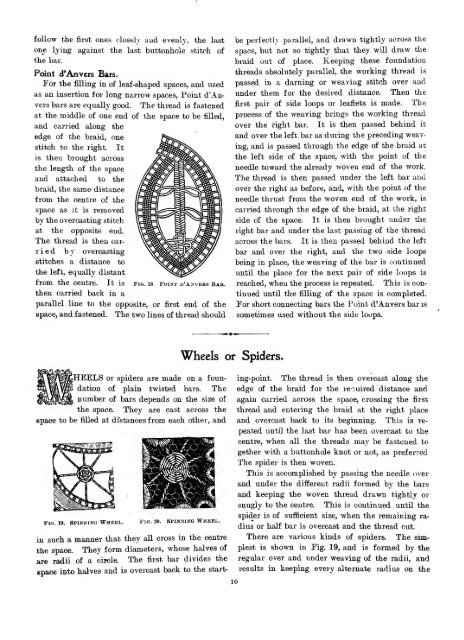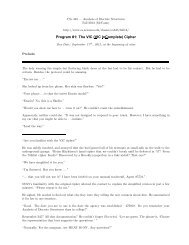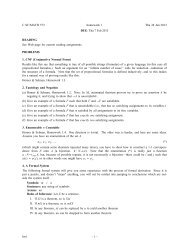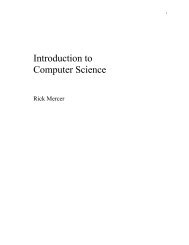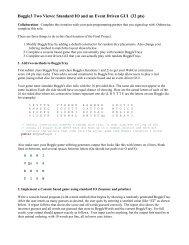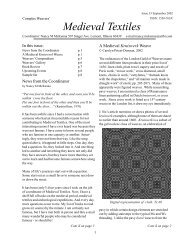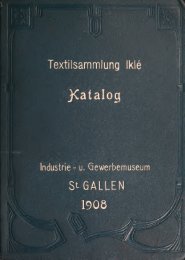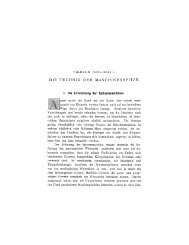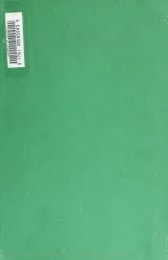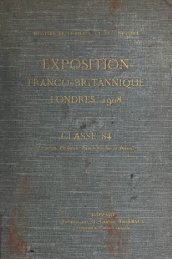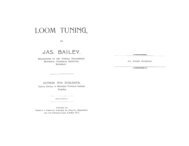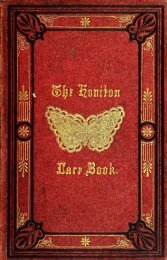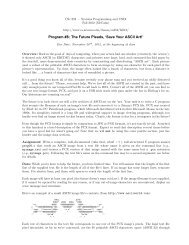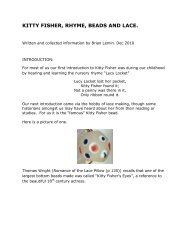The Priscilla Battenberg and point lace book; a collection of lace ...
The Priscilla Battenberg and point lace book; a collection of lace ...
The Priscilla Battenberg and point lace book; a collection of lace ...
You also want an ePaper? Increase the reach of your titles
YUMPU automatically turns print PDFs into web optimized ePapers that Google loves.
follow the first ones closely <strong>and</strong> evenly, the last<br />
one lying against the last buttonliole stitch <strong>of</strong><br />
the bar.<br />
Point d'Anvcrs Bars.<br />
For the filling in <strong>of</strong> leaf-shaped spaces, <strong>and</strong> used<br />
as an insertion for long narrow spaces, Point d'An-<br />
vers bars are equally good. <strong>The</strong> thread is fastened<br />
at the middle <strong>of</strong> one end <strong>of</strong> the space to be filled,<br />
<strong>and</strong> carried along the<br />
edge <strong>of</strong> the braid, one<br />
stitch to the right. It<br />
is then brought across<br />
the length <strong>of</strong> the space<br />
<strong>and</strong> attached to the<br />
braid, the same' distance<br />
from the centre <strong>of</strong> the<br />
space as it is removed<br />
by the overcasting stitch<br />
at the opposite end.<br />
<strong>The</strong> thread is then car-<br />
r i e d by overcasting<br />
stitches a distance to<br />
the left, equally distant<br />
from the centre. It is<br />
then carried back in a<br />
Fig. 18. PoiST d'Axvebs Bab.<br />
parallel line to the opposite, or first end <strong>of</strong> the<br />
space, <strong>and</strong> fastened. <strong>The</strong> two lines <strong>of</strong> thread should<br />
^HEELS or spiders are made on a foundation<br />
<strong>of</strong> plain twisted bars. <strong>The</strong><br />
number <strong>of</strong> bars depends on the size <strong>of</strong><br />
the space. <strong>The</strong>y are cast across the<br />
space to be filled at distances from each other, <strong>and</strong><br />
Fig. 19. Spinning Wheel. KiG. 20. Spinning Wheel.<br />
in such a manner that they aU cross in the centre<br />
the space. <strong>The</strong>y form diameters, whose halves <strong>of</strong><br />
are radii <strong>of</strong> a circle. <strong>The</strong> first bar divides the<br />
space into halves <strong>and</strong> is overcast back to the start-<br />
Wheels or Spiders.<br />
be perfectly parallel, <strong>and</strong> drawn tightly across the<br />
space, but not so tightly that they will draw the<br />
braid out <strong>of</strong> p<strong>lace</strong>. Keeping these foundation<br />
threads absolutely parallel, the working thread is<br />
passed in a darning or weaving stitch over <strong>and</strong><br />
under them for the desired distance. <strong>The</strong>n the<br />
first pair <strong>of</strong> side loops or leaflets is made. <strong>The</strong><br />
process <strong>of</strong> the weaving brings the working thread<br />
over the fight bar. It is then passed behind it<br />
<strong>and</strong> over the left bar as during the preceding weav-<br />
ing, <strong>and</strong> is passed through the edge <strong>of</strong> the braid at<br />
the left side <strong>of</strong> the space, with the <strong>point</strong> <strong>of</strong> the<br />
needle toward the already woven end <strong>of</strong> the work.<br />
<strong>The</strong> thread is then passed under the left bar <strong>and</strong><br />
10<br />
over the right as before, <strong>and</strong>, with the <strong>point</strong> <strong>of</strong> the<br />
needle thrust from the woven end <strong>of</strong> the work, is<br />
carried through the edge <strong>of</strong> the braid, at the right<br />
side <strong>of</strong> the space. It is then brought under the<br />
right bar <strong>and</strong> under the last passing <strong>of</strong> the thread<br />
across the bars. It is then passed behind the left<br />
bar <strong>and</strong> over the right, <strong>and</strong> the two 'Side loops<br />
being in p<strong>lace</strong>, the weaving <strong>of</strong> the bar is continued<br />
until the p<strong>lace</strong> for the next pair <strong>of</strong> side loops is<br />
reached, when the process is repeated. This is con-<br />
tinued until the filling <strong>of</strong> the space is completed.<br />
Por short connecting bars the Point d'Anvers bar is<br />
sometimes used without the side loops.<br />
ing-<strong>point</strong>. <strong>The</strong> thread is then overcast along the<br />
edge <strong>of</strong> the braid for the required distance <strong>and</strong><br />
again carried across the space, crossing the first<br />
thread <strong>and</strong> entering the braid at the right p<strong>lace</strong><br />
<strong>and</strong> overcast back to its beginning. This is re-<br />
peated until the last bar has been overcast to the<br />
centre, when all the threads may be fastened to<br />
gether with a buttonhole knot or not, as preferred<br />
<strong>The</strong> spider is then woven.<br />
This is accomplished by passing the needle over<br />
<strong>and</strong> under the different radii formed by the bars<br />
<strong>and</strong> keeping the woven thread drawn tightly or<br />
snugly to the centre. This is continued until the<br />
spider is <strong>of</strong> sufficient size, when the remaining ra-<br />
dius or half bar is overcast <strong>and</strong> the thread cut.<br />
<strong>The</strong>re are various kinds <strong>of</strong> spiders. <strong>The</strong> sim-<br />
plest is shown in Fig. 19, <strong>and</strong> is formed by the<br />
regular over <strong>and</strong> under weaving <strong>of</strong> the radii, <strong>and</strong><br />
results in keeping every alternate radius on the


